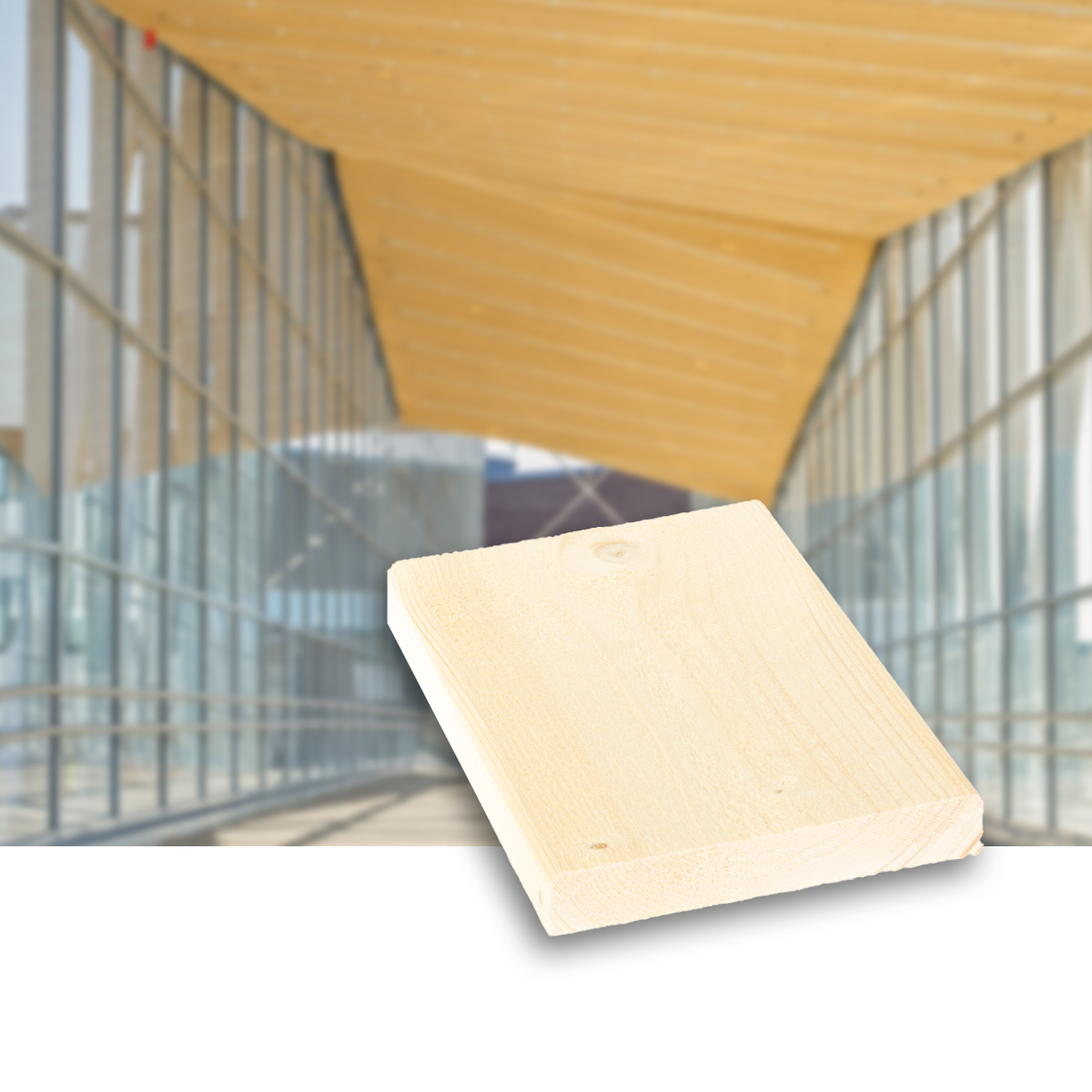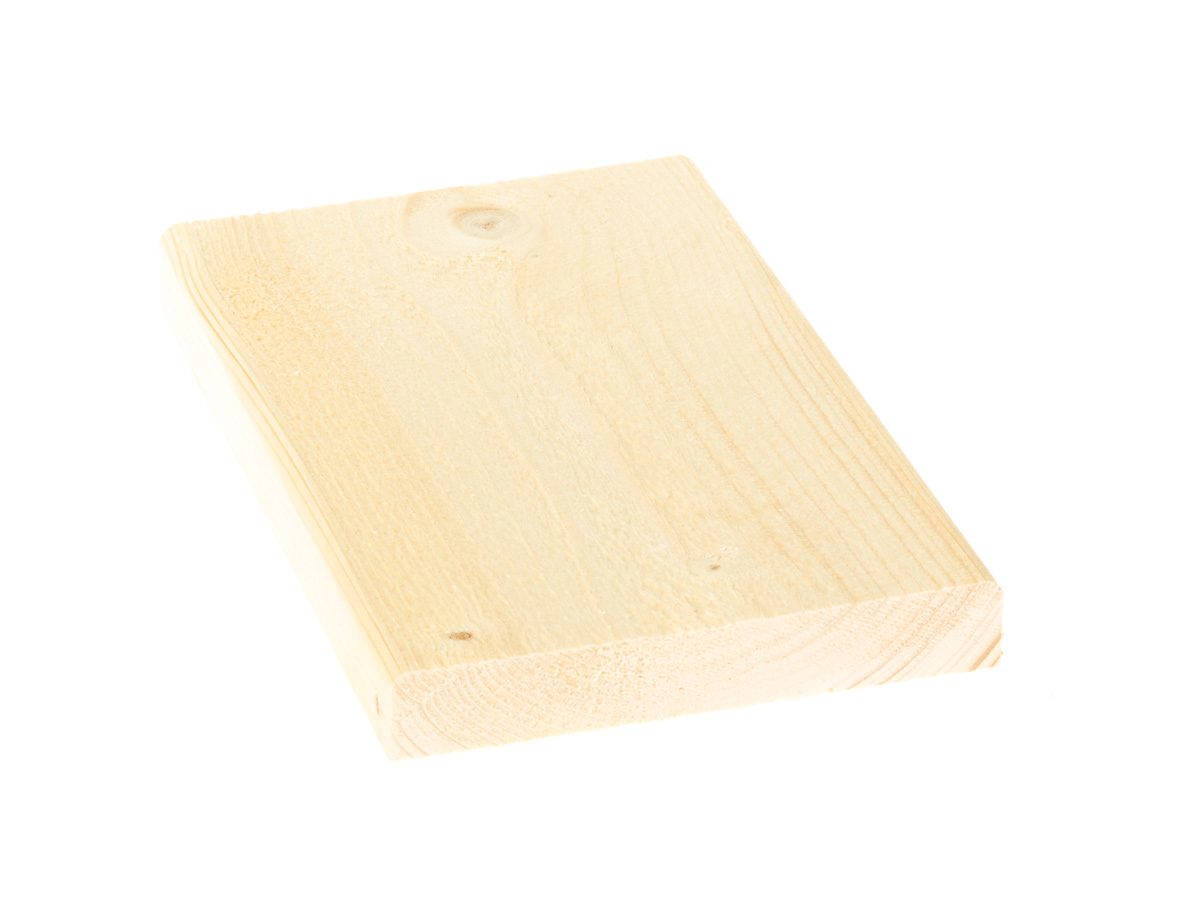



✅ Made from Finnish wood, responsibly produced
✅ Completely natural and safe product
✅ Light and fresh appearance
✅ Handles moisture fluctuations well
✅ PEFC-certified
| Length | Available | |
|---|---|---|
| 4.20 m | 1,268.40 m | |
| 4.80 m | 787.20 m |
✅ Finnish wood, responsibly manufactured in Lempäälä
✅ Completely natural and safe product
✅ Light and fresh appearance
✅ Excellent resistance to moisture fluctuations
✅ PEFC-certified
Our product uses spruce, a domestic, versatile, and strong softwood that handles moisture changes well. Easy to work with and finish, spruce is ideal for interior use, saunas, and, when treated, exterior cladding. Its warm light color and straight-grained pattern make spruce an aesthetically pleasing choice for visible surfaces. Our PEFC-certified spruce products are responsibly produced and environmentally friendly.
Please note that we deliver our products in bundles. Bundle size is indicated together with stock information on top right corner.
| Tuotenumero | 4973 |
| Tuotenimi | KUUSILAUTA 23x120 KHP PUUVALMIS |
| Saatavuus | Tuote poistuu valikoimasta |
| Toimitusaika | 6 päivää, kun tuotetta varastossa |
| Puulaji | Kuusi |
| Vahvuus (mm) | 23 |
| Leveys (mm) | 120 |
| Paino (kg/myyntiyksikkö) | 1,159 |
| Neliömenekki (m/m²) | 8,00 |
| Hiilijalanjälki (CO2e kg/jm) | 0,12 |
| Hiilikädenjälki (CO2e kg/jm) | -2,09 |
Highlighting Wood’s Best Qualities with Surface Treatment
Surface treatment brings out the best in wood and tailors high-quality timber to its intended use. Beyond durability and fire safety, it adds color that perfectly complements your project.
Durability and versatility can be further enhanced with industrial painting or finishing suited to your needs. Pre-finished or treated wood also speeds up and simplifies work during tight construction or renovation schedules.
Wood is a high-quality, versatile material that, after industrial painting or surface treatment, performs even better in various conditions. Our extensive practical experience and expertise in wood finishing guide us on how to treat material for different applications.
Not all wood requires finishing before use, but treatments can highlight specific properties. For example, sauna wood benefits from protective coatings designed to withstand high temperatures and humidity. Surface treatment can also extend a wood product’s lifespan.
The choice of treatment often depends on the wood’s application. Properly treated wood adds structure and character to interior and exterior surfaces. Opaque painting or translucent finishes allow you to achieve the exact color that best fits your interior design and overall building aesthetic.
All painting and finishing work is done in our industrial paint shop. We use water-based, eco-friendly coatings and paints from reputable manufacturers. Our fire-retardant treatments can bring wood to a B-s1, d0 fire class.
To operate as environmentally responsibly as possible, a batch must be at least 500 meters. This minimizes raw material waste and keeps our operations efficient.
Storage of Outdoor Products
- Products should be protected from direct sunlight and rain before installation.
- Products should be stored horizontally on a flat surface, in unopened packages, and elevated at least 75 mm from the ground so that air can circulate underneath the stack.
- Sunlight and moisture together can cause boards to start graying in spots even before installation; if this happens, the color will even out after installation.
Installation
Our exterior cladding boards and panels are finely sawn spruce, providing an excellent surface for painting. During installation, the moisture content of the wood must be below 20%, as wood shrinks as it dries. For painted cladding, the moisture content should not exceed 15–18%, depending on the paint type.
For a balanced and visually calm result, avoid combining vertical and horizontal cladding on the same façade, as this often leads to excessive trim work and technically challenging details. Choose a vertical or horizontal cladding solution that suits the building and environment, aiming for a simple and clear overall appearance.
Requirements for durable and long-lasting exterior cladding:
- Use sufficiently thick cladding boards; recommended thickness is 28 mm.
- Use industrially primed cladding boards.
- Ensure the board is heartwood.
- Install boards with the heartwood side facing out if not using industrially finished boards.
- Avoid joints, or use tongue-and-groove boards at the ends.
- Shape the lower edge of the cladding as a drip edge.
- Leave an open ventilation gap of about 22–25 mm from bottom to top behind the cladding.
- The base (plinth) height should position the bottom of the cladding at least 300 mm above ground.
- Properly functioning window flashings and trims.
- Effective gutters and downpipes.
- Roof eaves width at least 300 mm, preferably 600 mm.
- Regular maintenance painting of exterior cladding.
Fastening
Cladding boards are usually fastened to the substrate with hot-dip galvanized wire nails. Nail length should typically be at least 75 mm. The spacing between fastening points is usually 600 mm. Each board should be nailed with two nails at each fastening point, approximately 20–25 mm from the board edges.
- For horizontal cladding, install vertical battens through the wind barrier, securely attached to the wall studs.
- For vertical cladding, install horizontal battens, attached through the wind barrier to the wall studs, with spacers or battens ensuring air circulation.
- If using a pneumatic nailer, ensure nails do not sink too deep and damage the wood surface. The nail head must not be recessed, as this can allow water to penetrate the wood.
- Use nails designed for exterior cladding and full-head strip nails, so nail depth can be adjusted during installation.
Surface Treatment of Exterior Cladding
Paint the wooden cladding as soon as possible after installation. You can find guidance for painting methods in industry literature such as RT instruction cards and in paint manufacturers’ product data sheets. Cladding can also be made using boards that are factory-primed. Primer provides protection against rain and sunlight during installation and speeds up painting work, as you can proceed directly to topcoating after installation. When buying boards, check in advance which topcoat types are compatible with the primer.
Maintenance Painting
Proper and timely maintenance painting is essential for the long-term durability of wooden exterior cladding, except for Douglas fir, which does not require surface treatment.
When performing maintenance painting, clean dirt thoroughly to ensure good paint adhesion and to prevent mold or other impurities from growing through the new paint surface. Washing with a mold remover kills mold and growths and wears the old paint surface, improving adhesion for the new paint. Protect surfaces you are not treating, such as windows, with plastic during washing. Begin exterior painting on a dry, cloudy day following a few sunny days that have dried the wood surface. Painting in direct sunlight is not ideal. A good working temperature is about +15–20 °C with around 50% relative humidity. It should also remain dry and warm while the paint dries.
The surface to be painted must be dry and not too hot. Paint so that the sun will not shine directly on the freshly painted wall. The drier the wood, the better the surface treatment will absorb and adhere. Start painting after the morning dew has dried and finish well before the evening dew falls. Do not paint if rain is expected.
Wood, when used correctly, is a long-lasting and functional exterior cladding material. For facades, spruce, pine heartwood, Douglas fir, heat-treated spruce, or pine are recommended. Our exterior cladding products are made from either spruce or Douglas fir. Douglas fir is a durable material for both exterior and interior use.
Proper and timely maintenance painting is essential for the long-term durability of wooden exterior cladding, except for Douglas fir, which does not require surface treatment. Douglas fir’s advantage is its low maintenance—while it has a higher purchase price as a premium raw material, its life-cycle cost is lower compared to painted spruce cladding, as it does not require repainting.
Using factory-primed (PM) exterior cladding boards reduces on-site costs and saves time. Primer protects the boards from rain and sunlight during installation and speeds up painting work, allowing direct topcoating after installation.
Fine-Sawn Boards
Fine-sawn timber is typically dry-sawn with a band saw. Its rough surface provides an excellent grip for paint, resulting in a durable finish. Dry-sawn wood has a shorter fiber surface than green-sawn timber. Boards may be fine-sawn on one or multiple sides, and are suitable, for example, as corner or fascia boards.
Exterior Cladding Panels
For facade cladding, Douglas fir or spruce (grade AB) is recommended. Spruce has a cell structure that “closes” when dry, making its surface similar from sapwood to heartwood, like pine heartwood. Pine sapwood remains “open,” and only its heartwood is closed. Because of its structure, spruce absorbs less moisture and swells less than pine, making it slightly better suited for facade use.
Slanted Battens (Lattice Slats)
Slanted battens, or lattice slats, are mainly used as privacy screens for terraces, carports, and garden structures. They can be used to create stylish fences, railings, canopies, and decorative structures, adding both privacy and comfort to outdoor spaces. Coverage depends on installation spacing, and battens can also add decorative detail to building facades.
The profile of slanted battens is carefully designed for easy cleaning. The upper slope is installed so water runs off, reducing debris buildup. They can be installed at two different angles.
Glulam Posts
These laminated posts are weather-resistant. Their cut ends should be protected—e.g., with post caps or a handrail—to prevent excessive water absorption, especially on exposed decks or piers.
Durability
Douglas fir is durable and requires no surface treatment. When exposed to the weather, it naturally turns grey; this can be accelerated within a few weeks using ferrous sulfate.
Other weather-exposed surfaces not made from Douglas fir require treatment, as they absorb moisture and may develop mold. Fine-sawn surfaces are excellent for painting due to their rough texture, which ensures strong adhesion. Common uses include fences, canopies, and corner or fascia boards.
Lauta.fi delivers product sample pieces to both consumer customers and professionals, such as architects, interior architects and designers, construction industry and procurement professionals.
If you are interested in ordering one or more sample pieces, please contact our sales department via email lauta@lauta.fi or phone +358 3 3123 6000 (On weekdays 8-16).